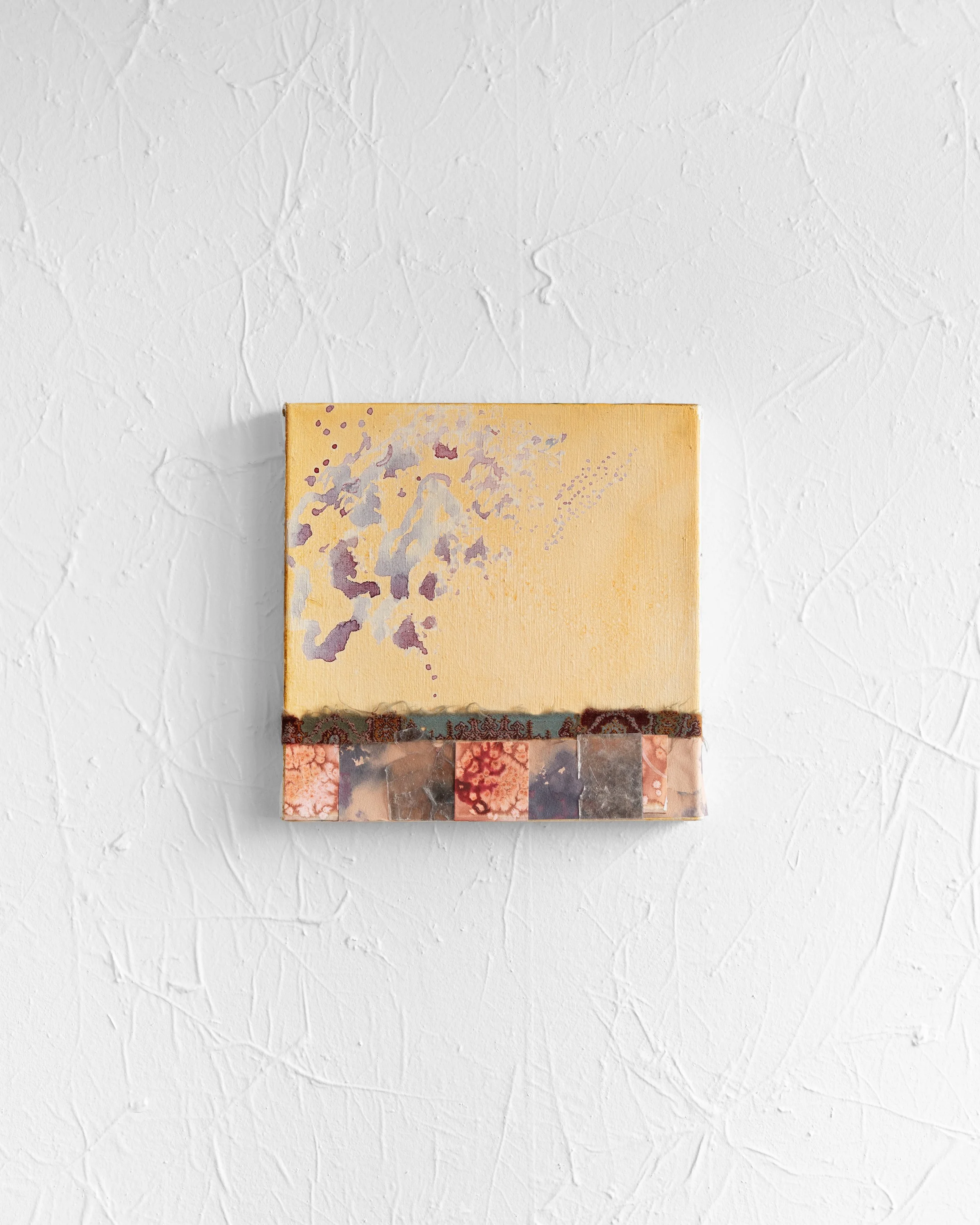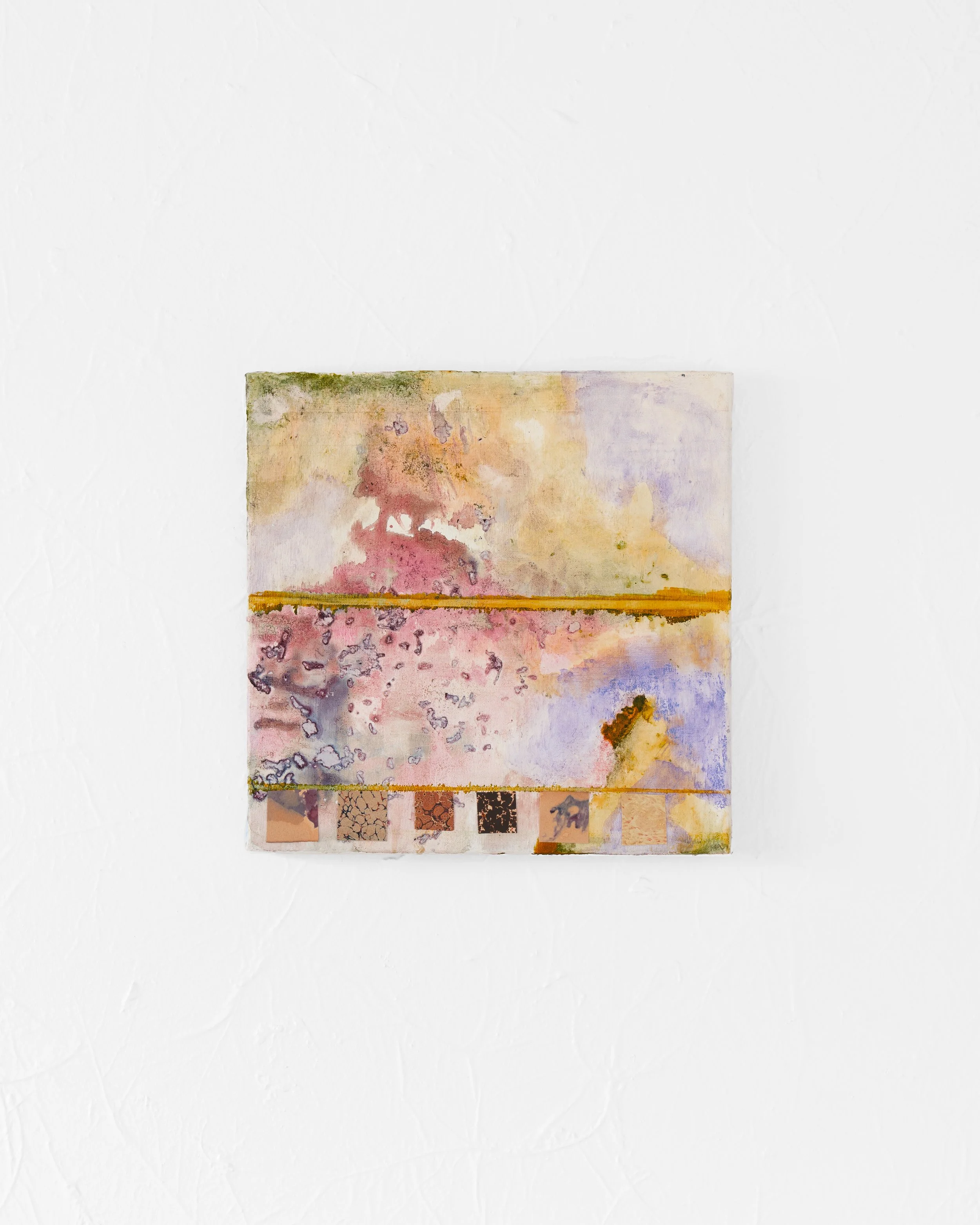Present Tense
Kirstyn Hom and Sibyl Rubottom
Curated by Lizzie Zelter
July 11 - August 9, 2025
Sibyl Rubottom The Bowl Breaks: Meissen, 2025 Drywall, porcelain, lace, acrylic, gold leaf 24 x 24 x 1 ½ in.
Kirstyn Hom (a)wake, 2025 Hand painted devoré cotton polyester voile, fiber reactive dye 84 x 41 in. (left, right), 82 ½ x 16 ½ in. (middle)
Sibyl Rubottom Sacher Torte Suite, 2025 Eight artist books, gold leaf, marbled paper, archival documents 8 ½ x 8 ½ x 2 ½ in.
Kirstyn Hom carried over, 2025 Cotton organdy fabric, weld dye, logwood dye, hook and eye closures, polyester thread, silk yarn, wire hanger 27 x 48 in.
Installation view
Sibyl Rubottom Channeling Vera Rubin, 2025 Hibiscus ink, vintage textile, hand-dyed paper, mica 12 x 12 x 1 ¼ in.
Sibyl Rubottom Garden House Library, 2010 Three artist books, collage, etchings 7 x 4 x 3 in.
Garden House Library, detail
Sibyl Rubottom Aurelia’s Shoes, 2025 Hibicus ink, paper, printed etching 10 x 10 x 1 ½ in.
Kirstyn Hom wrack line, 2025 Brown and red seaweed eco prints, chestnut bark tannic acid, cotton fabric, cotton batting, polyester thread, raw and habotai silk fabric 23 in. x 44 ft. 9 in. x 16 in.
Sibyl Rubottom Viennese Prayer Flags, 2025 Hibiscus ink, vintage marbled paper 12 x 12 x 1 ¼ in.
Installation view
Sibyl Rubottom Baby Shoes: They are all grown up now, 2025 Acrylic on canvas, artist frame 30 ½ x 30 ½ x 1 ½ in.
Sacher Torte Suite, detail
Two Rooms is proud to share Present Tense, a two-person exhibition featuring Kirstyn Hom (b. 1990, San Francisco, CA) and Sibyl Rubottom (b. 1942, New York, NY). Working across textile, painting, and book arts, Hom and Rubottom engage in multi-generational dialogues with relatives from Guangdong, China, and Vienna, Austria. Both artists reinvigorate diasporic materials, forms, and phrases from the prior century, bringing them into a contemporary context to form new site-specific tapestries and libraries.
Using experimental craft techniques and dyes from ephemeral plant matter, Hom’s practice preserves memory, processes loss, and carves spaces of belonging. Her sculptural installations are labor-intensive and charged with stories from the past and ideals for today. Hom investigates the form of the written word, the loss of the “mother tongue,” and the embodiment of assimilation by employing tactile and visual strategies of repetition and ambiguity.
For this exhibition, Hom produced three site-specific textile pieces that reference outerwear, curtains, and netting. Carried over draws from stories of Hom’s grandmother sewing pockets inside her coat to carry belongings while leaving home. Hom’s reimagining of the coat utilizes resist dye techniques to reveal the imprint of keys temporarily pressed against each pocket. The ghostly pattern reflects experiences of losing entry, cycles of relocation, and the persistence of finding new openings.
In her tri-panel installation, a(wake), Hom inscribes the panels with a haiku repeating from top to bottom: “a rupture pulls us awake / a wake rises inside me”. By using devoré, a chemical process that dissolves a layer of mixed fibers, Hom imbues the wavelike script with an incandescent shimmer. The subtractive process of burning away the fabric becomes a form of loss that allows for the possibility of something new. Influenced by Dr. Christina Sharpe’s concept of “wake work” as a framework to actively confront the ongoing impact of the transatlantic slave trade, Hom invites multiple readings of the words “awake” and “a wake” for living alongside grief and finding possibility in the ruptures that surround us.
Wrack-line, the quilted floor piece that wraps the margins of the second room, evokes the shifting borders between land and sea. Layers of the quilt are cut away in a reverse appliqué method to form netting that hovers above an interior pattern of eco-printed brown and red seaweeds collected from San Diego beaches. To enter the piece is to be caught and held in an interconnected web that begins fixed to the four walls and softens into a lapping shoreline.
Rubottom’s six-decade career has spanned painting, collage, textile, printmaking, book arts, and letterpress. Her throughline is an inquisitive and assiduous approach to geometric and organic forms, natural elements and dyes, and the gamut of typography. Her wheelhouse of motifs contains concentric squares, checkerboard patterns, prayer flags, porcelain, broken fragments, tumbling blocks, objects in flight, houses, wallpaper, paisley, playing cards, the cosmos, celestial forms, and gold leaf.
For Present Tense, Rubottom uses personal heirlooms, such as Meissen porcelain, her mother’s Viennese bedspread, and her father’s archival immigration paperwork. Having saved these objects over the decades, Rubottom works directly with these potent relics for this exhibition. The Bowl Breaks: Meissen is the most recent iteration of paintings Rubottom has made in honor of Rumi’s poem “The New Rule.” The delicate fragments of broken porcelain became more precious to her than the whole. The jagged-edged floating form symbolizes imperfection, acceptance, and freedom; a mantra Rubottom returns to time and again.
Rubottom’s eight-foot Viennese Tumbling Blocks tapestry is a sewn arrangement of diamonds and triangles positioned to create a geometric optical illusion. The repetitive expansiveness of this piece allowed Rubottom to reflect on her family in a meditative, non-verbal way. Each of the more than 300 individual blocks was a step towards attempting to get to know family members that were killed in the Holocaust in the years surrounding her birth in 1942. The layered boxes nested within one another evoke a reversed family tree, each row emerging from the one beneath, and holding up what comes next.
The Eco-Print Library shares a genealogical feel. In Rubottom’s hand-made accordion books, onion skins and eucalyptus leaves are pressed into the folds, leaving their traces throughout the pages. The books are suspended on shelves covered by her mother’s bedspread from 19th-century Vienna, a memory blanket of sorts. Her Sacher Torte Suite is a series of eight artist-books made by collaging her father’s immigration documents, WWII security envelope patterns, prayer flags, and botanical drawings. They are held together in a wooden box that previously contained a Sacher Torte, a traditional Austrian chocolate sponge cake. Rubottom often crafts small containers or dwellings for her books so they may live amongst one another.
Floating shoes and sandals are suspended within orderly squares in Baby Shoes: They are all grown up now and Aurelia’s Shoes. For years, Rubottom has collected and drawn shoes from street markets, friends’ children, and her own now-grown sons. Their positions convey a vortex where the shoes are hurtling from past to present. Adorning the background is a modernist wallpaper design adapted from a portrait of her grandfather along with psychedelic cartoon doodles Rubottom made in the 1960s. In a uniquely Rubottom maneuver, she collapses her time-space continuum into a unified field.
In Present Tense, Hom and Rubottom consider how their family histories live within them at this moment. They embrace multiplicity and repair within the act of creation, each speaking of their processes as meditative. Their work is filled with echoes and rhymes, expressing reverberations of stories from before their times. Present Tense is an invitation into a multi-generational conversation between two artists and their origins.














